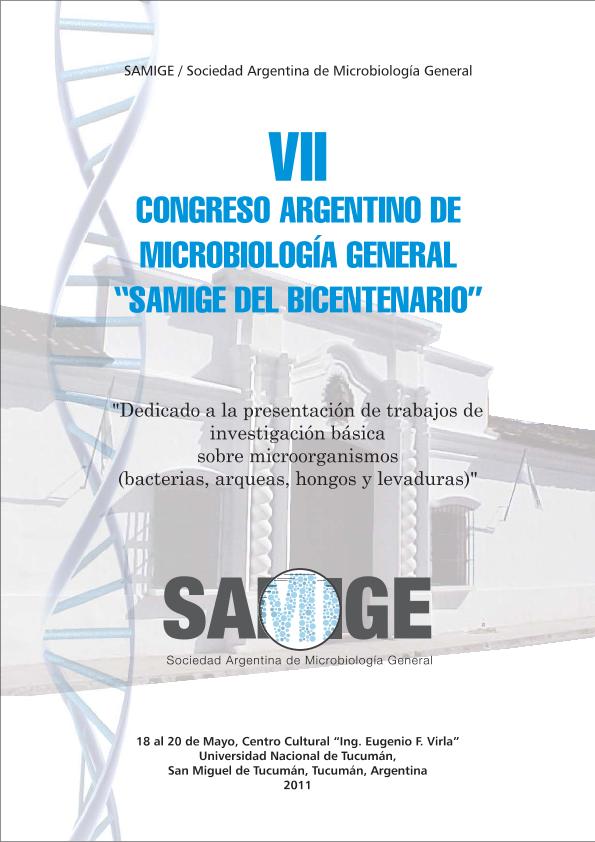Evento
Cr(VI) bioremediation by Streptomyces sp. MC1: Effect on Zea mays
Atjian, Mariana Cristina; Polti, Marta Alejandra ; Amoroso, Maria Julia del R.
; Amoroso, Maria Julia del R. ; Abate, Carlos Mauricio
; Abate, Carlos Mauricio
 ; Amoroso, Maria Julia del R.
; Amoroso, Maria Julia del R. ; Abate, Carlos Mauricio
; Abate, Carlos Mauricio
Tipo del evento:
Congreso
Nombre del evento:
VII Congreso Argentino de Microbiología General
Fecha del evento:
18/05/2011
Institución Organizadora:
Sociedad Argentina de Microbiología General;
Título del Libro:
VII Congreso Argentino de Microbiología General
Editorial:
Sociedad Argentina de Microbiología General
Idioma:
Inglés
Clasificación temática:
Resumen
In natural water and subsurface soils, chromium (Cr) occurs in two major oxidation states: III and VI. Cr(VI)is the major chromium species used in industry and is the common pollutant in soil and waste water, while Cr(III) is a relatively insoluble and non-toxic. Cr(VI) produce toxicity acute and chronic, neurotoxicity, dermatotoxicity, genotoxicity, carcinogenicity and immunotoxicity. Cr(VI) compounds are 1,000 fold more toxics than Cr(III) compounds. Biological transformation of Cr(VI) to Cr(III) by enzymatic reduction is a means of decontamination. This biological reduction may provide a less costly and environmentally friendly approach to remediation. On the other hand, vegetables can be used as contamination level markers because they can accumulate these compounds. A Cr(VI) resistant actinobacteria strain, Streptomyces sp. MC1, previously isolated, in our lab, from sugar cane, has the ability of reducing Cr(VI) in sterile soil samples.The aim of this work was to evaluate the ability of this strain to bioremediate non sterile soil samples contaminated with Cr(VI), using Zea mays as bioindicator. Streptomyces sp. MC1 was grown in Tryptic Soy Broth (g L-1: Tryptone 15, Soy Peptone 3, NaCl 5, K2HPO4 2.5 and glucose 2.5) during 3 days at 30 ºC. Glass pots were filled with 200 g of soil and kept at 20% humidity with distilled water. K2Cr2O7 solution was added at final Cr(VI) concentration of 200 mg kg -1 of soil. Later these soil samples were inoculated with pre-cultured Streptomyces sp. MC1.Zea mays seeds were sterilized and sown on plates with agar. Maize young plants were potted at the same time of Streptomyces inoculation (t0), 14 days (t14) and 28 days (t28) after the inoculation, and cultivated during 14 days. Chromium bioavailability was measured by atomic absorption spectrophotometry (AAS) after centrifugation 1 g of soil at 5540 g. Maize biomass was estimated as dry weight. Chromium accumulate by plants was measured by AAS after plant treatment with concentrated H2SO4. Streptomyces sp. MC1 was able to reduce Cr(VI) bioavailability up to 73% after 42 days. Similarly, Zea mays reduced up to 70% of chromium bioavailability, in absence of Streptomyces sp. MC1.On the other hand, Zea mays biomass decreased up to 88% with Cr(VI) and without Streptomyces sp. MC1. However, Zea mays biomass decreased only 32% in presence of Cr(VI) and Streptomyces sp. MC1, when the sow was made after 28 days of inoculation, and Cr(VI) bioavailability was reduced up to 97%. This is the first report where Streptomyces sp. MC1 and Zea mays show a synergic effect that could be useful to bioremediate Cr in soil samples.
Palabras clave:
CR(VI) BIOREMEDIATION
,
STREPTOMYCES
,
ZEA MAYS
Archivos asociados
Licencia
Identificadores
Colecciones
Eventos(PROIMI)
Eventos de PLANTA PILOTO DE PROC.IND.MICROBIOLOGICOS (I)
Eventos de PLANTA PILOTO DE PROC.IND.MICROBIOLOGICOS (I)
Citación
Cr(VI) bioremediation by Streptomyces sp. MC1: Effect on Zea mays; VII Congreso Argentino de Microbiología General; San Miguel de Tucumán; Argentina; 2011; 34-34
Compartir



